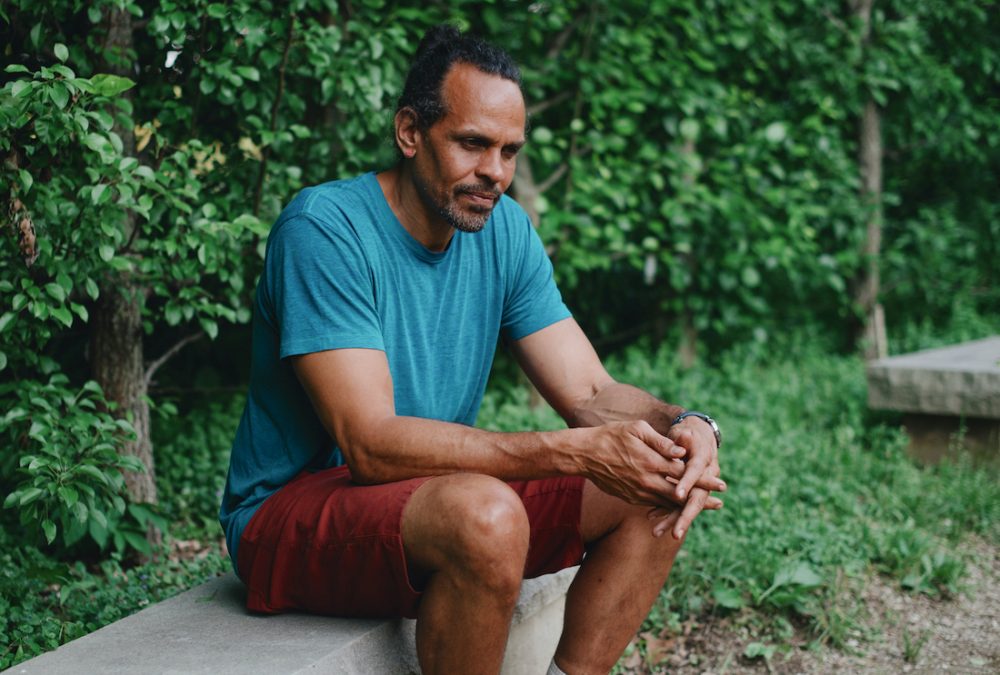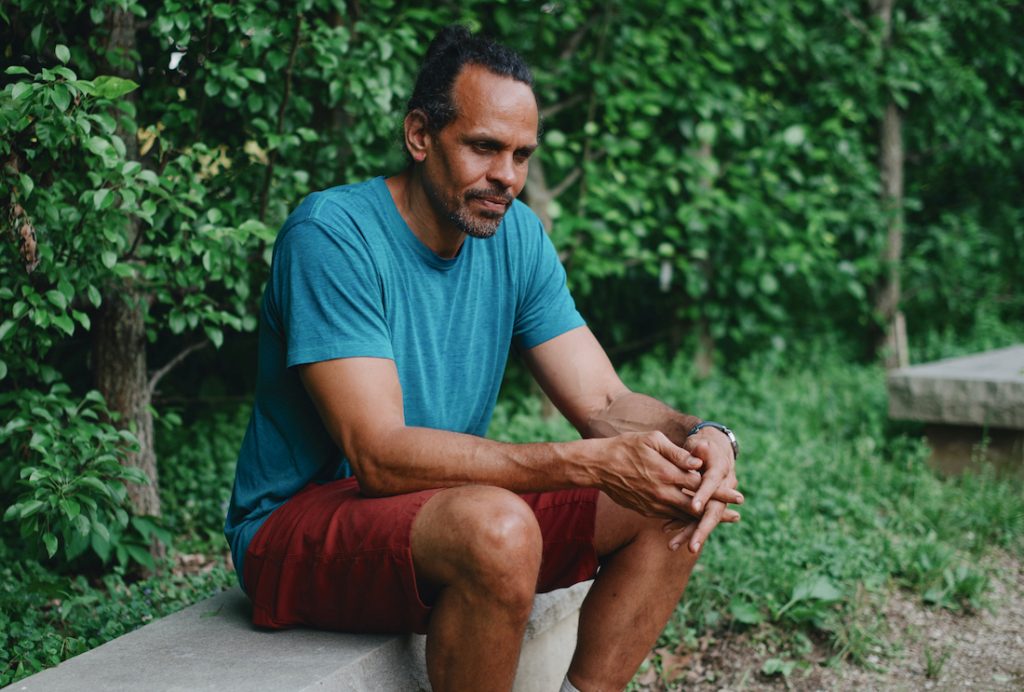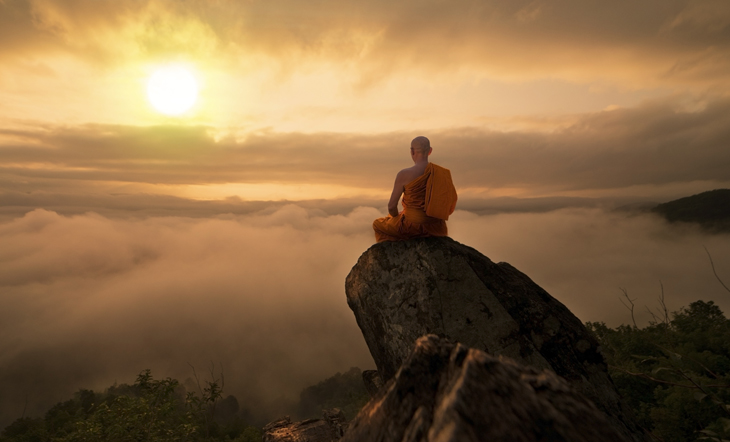Inviting Sorrow in for Tea
In a recent episode of Life As It Is, poet Ross Gay discusses why he believes that joy is a radical and necessary act. The post Inviting Sorrow in for Tea appeared first on Tricycle: The Buddhist Review.

Personal Reflections Life As It Is
In a recent episode of Life As It Is, poet Ross Gay discusses why he believes that joy is a radical and necessary act.
Ross Gay in conversation with James Shaheen and Sharon Salzberg Apr 02, 2023 Photo by Natasha Komoda
Photo by Natasha KomodaIt can be so easy to dismiss joy as frivolous or not serious, especially in times of crisis or despair. But for poet Ross Gay, joy can be a radical and necessary act of resistance and belonging. In his new essay collection, Inciting Joy, Gay explores the rituals and habits that make joy more available to us, as well as the ways that joy can contribute to a deeper sense of solidarity and care.
In a recent episode of Life As It Is, Tricycle’s editor-in-chief, James Shaheen, and co-host Sharon Salzberg sat down with Gay to talk about finding joy in the midst of grief and sorrow, the dangers of believing ourselves to be self-sufficient, and how joy can dissolve the boundaries between us. Read excerpts from their conversation below, and then listen to the full episode.
James Shaheen (JS): At the beginning of the book, you mention a student who said they’d always been told they couldn’t write about joy because it wasn’t serious enough. How do you understand a comment like that?
Ross Gay (RG): Sometimes people see joy as a kind of lightweight or consumerist emotion. And that’s not it at all. Joy emerges from the understanding that we live in the midst of profound difficulty, and it seems to me to be about the practices of entanglement. When we’re entering these practices of understanding that we belong to one another, that we are not separable from one another, what comes from doing those practices is joy.
Joy is so powerful because it reminds us that we can belong. Culturally, there’s a kind of profound alienation that people are experiencing, and I feel like joy itself is the evidence of a feeling of belonging. That feeling of belonging can be mutual heartbreak. It can be a gathering around all kinds of things. But it does feel like it is the evidence of the belonging to one another, and that feeling of belonging incites more stuff by which we understand we belong to one another. I want to be able to articulate all these ways that we do this daily. I want to be able to notice the ways that as I’m walking down the street, going to get my coffee, or whatever, I’m in the midst of a kind of remarkable care.
JS: Instead of imagining joy as separate from pain, you suggest that it emerges from how we care for each other through sorrow and suffering. Can you say more about how you came to this understanding of joy?
RG: I spent a lot of time fighting to avoid my sorrow and isolate myself from my sorrow, which is also a way of isolating myself from other people. One of the teachings that felt like a life-changing teaching happened at a mindfulness class at Thomas Jefferson Hospital in Philadelphia. We were doing a body scan meditation, and the teacher asked, “How’d it feel?” One of the students in the class said she didn’t like it. The teacher said, “Well, why not? Are you OK to talk about it?” And she said, “Well, it made me sad.” As this was going on in this class of thirty people, I realized that I literally couldn’t watch. I couldn’t look at them. It wasn’t like someone was having a finger cut off. It was someone saying they’re sad. But I couldn’t bear to look.
In my body, I was having the same exact feeling that I would have when I would visit my mother. My father had died recently, and my mother was really sad. It was so difficult to be with her in the midst of that sadness, and I learned to watch the ways I would try to get out of being with that sadness. Being with that sadness, to me, is called joy. Being with your mother in the midst of her sadness is one of the aspects of joy, I think.
Sharon Salzberg (SS): I think what you’re saying is so powerful because we can have so many conditioned reactions to that sense of sorrow, which is not allowed for many people. In the book you use an image of inviting sorrow in for tea, echoing the story of the Buddha inviting Mara to tea. But the tea soon turns into a neighborhood potluck full of dancing and raucous celebration. Can you say more about that image of the neighborhood potluck and the boisterousness that can come from sharing our sorrow?
RG: One of my hunches is that if we don’t reject our sorrow, then we don’t reject the sorrow of other people, and if we know that sorrow is not unique to us, maybe we are less inclined to be overcome by it. I think of that potluck itself as a kind of practice of entanglement. In the potluck, there’s a group of people who form a fermentation crew, and then a coven forms. People are dancing and making kites out of the obituary pages. It feels to me that all of these practices emerge as a way for people to acquaint themselves with and then be with their sorrows. When the sorrows get invited in, it’s actually a party where people figure out how to care for each other.
“Joy is so powerful because it reminds us that we can belong. “
JS: You organize the book around two guiding principles: investigating the rituals and habits that make joy available to us and exploring how joy makes us act and feel—in other words, what incites joy and what joy incites. Can you say more about these principles and how they’ve shaped how you see joy as a practice?
RG: The question of what incites joy goes back to the student who said, “Well, I’ve been told that joy isn’t serious. Why should I be thinking hard about joy?” And to me, what I’ve found is that what incites joy is, in fact, deadly serious, including the fact that we die, we grieve, we suffer, and so on. In the book, I talk about pick-up basketball. I talk about gardening. I talk about dancing. A lot of these things are ways that we practice making room for and accommodating as many of us as possible. Often, these are practices where the divisions between us get murky—like dancing, hard. The idea of you and me changes when you’re dancing. Any time you’re growing a garden, a very regular practice of the garden is to share. You’ve got extra zucchini; you share them. Your potato harvest was wild; you share the potatoes. That sharing itself troubles the boundary between you and me.
JS: You say that joy can kindle “a wild and unpredictable and transgressive and unboundaried solidarity,” which in turn can incite further joy. Can you tell us about this transgressive power of joy in bringing us together across boundaries?
RG: It’s my understanding, there’s extreme care in, say, a pickup basketball court or a strike. What does it mean when people who have been told they’re not supposed to care about each other really love something together and come together around something, whether it’s a song, a garden plot, or a waterway? It feels to me like it’s dangerous, that transgressive joy, that transgressive gathering.
![]()
Thank you for subscribing to Tricycle! As a nonprofit, we depend on readers like you to keep Buddhist teachings and practices widely available.
This article is only for Subscribers!
Subscribe now to read this article and get immediate access to everything else.
Already a subscriber? Log in.

 Hollif
Hollif 



















.jpg&h=630&w=1200&q=100&v=6e07dc5773&c=1)











![How To Win Brand Visibility in AI Search [Webinar] via @sejournal, @lorenbaker](https://www.searchenginejournal.com/wp-content/uploads/2025/09/2-222.png)
